Australia
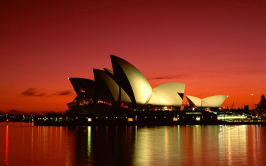
Australia is the only country that has a whole continent to itself. World famous for its natural wonders and wide open spaces, its beaches, deserts, "the bush", and "the Outback", Australia is actually one of the world's most highly urbanised countries. It is also well known for the cosmopolitan attractions of its large cities such as Sydney, Melbourne, Brisbane and Perth.
Wildlife
Australian flora and fauna is unique to the island continent, the result of having been isolated from the rest of the world for millions of years. Amongst Australian animals are a large group of marsupials (mammals with a pouch) and monotremes (mammals that lay eggs). Just some of the animal icons of Australia are the kangaroo (national symbol) and the koala. A visit to Australia would not be complete without taking the chance to see some of these animals in their natural environment.
Wildlife parks and zoos
- Wildlife parks and zoos are in every capital city, but also check out the animal parks if you are passing through smaller towns, like Mildura or Mogo, or staying on Hamilton Island. See the Warrawong Fauna Sanctuary if you are in South Australia, or visit the koalas with best view in the world, at Taronga Zoo in Sydney.
In the wild
- Kangaroos and wallabies reside in national parks all around the country. You won't see any kangaroos hopping down the street in Central Sydney, but they are abundant not too far from the centre of the nation's capital
- Wombats and Echidna are also common, but harder to find due to their camouflage and tunnelling. See lots of Echnida on Kangaroo Island
- Koalas are present is forests around Australia, but are very notoriously hard to spot, and walking around looking upwards into the boughs of trees will usually send you sprawling over a tree root. Best seen during the day, there is a thriving and friendly population on Raymond Island near Paynesville in Victoria. You have a good chance on Otway Coast, on the Great Ocean Road, or even in the National Park walk near Noosa on the Sunshine Coast.
- Emu are more common in central Australia. You will certainly see some if you venture to the outback national park at Currawinya
- Platypus are found in reedy flowing creeks with soft river banks in Victoria and Southern New South Wales - seen at dusk and dawn - you have to have a bit of luck to see one. Try the platypus reserves in Bombala or Delegate in New South Wales, or in Emu Creek at Skipton just out of Ballarat.
Landmarks
Australia has many landmarks, famous the world over. From Uluru in the red centre, to the Sydney Harbour Bridge and Opera House in Sydney.
New Zealand
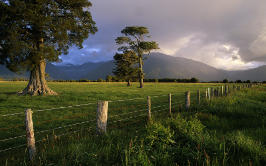
New Zealand is known in the native Maori language as Aotearoa, often translated as The land of the long white cloud.
New Zealand is a country of stunning and diverse natural beauty which includes: jagged mountains, steep fiords, pristine lakes, raging rivers, scenic beaches, and active volcanic features. The islands are one of Earth's richest flora zones and is inhabited by some unique fauna, including many flightless birds such as the kiwi, which is the national symbol.
The Maori culture continues to play an important part in everyday New Zealand life, and there are abundant opportunities for the visitor to understand and experience the history and the present day form of Maori life.
The country is sparsely populated but easily accessible. New Zealand has modern visitor facilities, and developed transportation networks. New Zealand often adds an adventure twist to nature, and is the home of jetboating through shallow gorges, and bungy jumping off anything high enough to give a thrill.
Mountains, lakes and glaciers
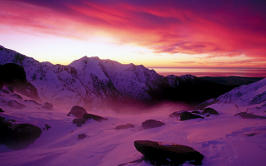
It can be said that in New Zealand it's the country that's magnificent, and perhaps no more so than the Southern Alps of the South Island. In the Mackenzie Country, the snow-capped jagged peaks rising above turquoise lakes have provided the inspiration for many a postcard. Tucked in behind is the country's highest peak, Aoraki Mount Cook. The lakes and mountains continue south, becoming a stunning backdrop for the towns of Wanaka, Queenstown and Glenorchy.
Another region where mountain meets water with striking effect is Fiordland National Park where steep, densely forested mountains rise from the sea. The most accessible, and possibly most beautiful spot, is Milford Sound. The road in is spectacular and the view even more so when you arrive.
Glaciers may not be the first thing that comes to mind when you think of an island in the South Pacific, but New Zealand has several. The most notable are the Fox and Franz Josef glaciers in Westland National Park. These glaciers are unique in how close they get to sea level and are sustained by the enormous amount of precipitation that falls on New Zealand's west coast.
Volcanoes and Geysers
New Zealand is a geological hotspot and has many dormant and active volcanoes, geysers and hot springs. The best place to start is Rotorua, where the smell of sulphur lets you know you're close to the action. The surrounding countryside has many parks with geysers and hot springs, and Mount Tarawera, the site of one of New Zealand's more famous eruptions, lies a short drive away.
South of Rotorua is Taupo and Lake Taupo, which was formed in a massive volcanic explosion thousands of years ago. Beyond Lake Taupo is Tongariro National Park, dominated by its three volcanoes, Tongariro, Ngauruhoe and Ruapheu. All three mountains are still active (Ruapehu last erupted in 2007) and Ruapehu has a crater lake that can be viewed with a bit of hiking. Ngauruhoe is famous for filling in as Mt. Doom in the Lord of the Rings trilogy.
North of Rotorua is Whakatane, with tours to White Island, a volcanic island just off the coast. The island is truly a different world with its smoke plume, green crater lake and the pohutukawa trees clinging to a fragile existence on the volcanic rock.
Flora and Fauna
Being so remote, New Zealand has very unique plants and animals. One of the most impressive is the kauri tree, one of the biggest species of tree in the world. Few of these giants are left (a result of overlogging), but a visit to the Waipoua Forest in Northland will afford a glimpse.
The beaches of the South Island, particularly The Catlins and the Otago Peninsula, are good places to see marine animals such as penguins, seals and sea lions in their natural habitat. The Otago Peninsula is also noted for its albatross colony.
Unfortunately, many of New Zealand's most unique animals are endangered and can only really be seen in captivity. This includes the kiwi, a common national symbol, the flightless takahe and the tuatara (a small lizard believed to have existed at the time of the dinosaurs).
Urban fare
While the countryside is the main attraction of New Zealand, it's worthwhile to spend some time in the cities. Auckland is a pleasant city with its waterfront districts like the Viaduct Harbour and Mission Bay, old volcanoes (Mt Eden and One Tree Hill), a handful of museums and the Sky Tower, the tallest freestanding building in the Southern Hemisphere. The more interesting architecture and the fine Te Papa museum can be found in Wellington, the capital. Napier is worth a stop, if you have the time, for its Art Deco downtown, and Christchurch is interesting for its English character.
Fiji
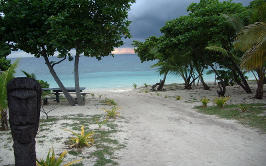
Fiji (sometimes called the Fiji Islands), is a Melanesian country in the South Pacific Ocean. It lies about two-thirds of the way from Hawaii to New Zealand and consists of an archipelago that includes 332 islands, a handful of which make up most of the land area, and approximately 110 of which are inhabited.
Fiji straddles the 180 degree longitude line (which crosses land on a remote tip of Vanua Levu and again near the centre of Taveuni), so the international date line jogs east, placing Fiji all in one time zone and "ahead" of most of the rest of the world.
Garden of the Sleeping Giant, Nadi, Fiji, The Garden of the Sleeping Giant was originally the garden of famed actor, Raymond Burr, and is located next to his house. The garden covers 20 hectares and is full of orchids native to Fiji and many flowers. With a beautiful lily pond and many exotic plants, this garden is sure to take your breath away.
The Fiji Museum is an excellent place for tourists to understand the historical background of Fiji. With artifacts dating back as far as 3,700 years it provides many exhibits that educate travelers on the nation's traditions and culture. The museum is located in heart of Suva’s botanical gardens.
Papua New Guinea
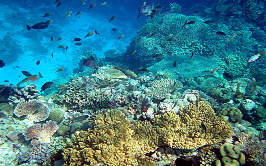
Papua New Guinea is an island nation in Oceania
South New Guinea
The Kokoda Trail is a 60-mile trail, beginning in the Port Moresby area and leading up into the Owen Stanley Range. This trail was first used by gold miners in the 1890s and is most known as a historical World War II site as the Japanese tried to reach Port Moresby along it. It takes about five days to hike this track, which includes plenty of ups and downs between mountain ridges and streams.
The Highlands
The Highland region is made of long string of fertile valleys, each separated by mountains, that mean the Highlands are composed of many distinct tribal regions.
In the Eastern Highlands is Mount Wilhelm, Papua New Guinea's highest mountain (14,880 feet). Climbing Wilhelm is relatively easy; but three or four days are recommended to allow for sightseeing. There are views of both the north and south coasts of New Guinea from the peak. The Wahgi River in this area is considered one of the best whitewater rafting destinations in the world.
The Northern Coast
Madang is good for scuba diving of all levels,and the coral reefs are home to a variety of rare species of colorful fish. There are also underwater wrecks of Japanese fighter planes, with weapons and cargo intact. There are still-active volcanoes for trekkers to hike up not far from Madang.
Further west you come to Wewak. It is the gateway to the Sepik River region with a fascinating culture distinct from that of the Highlands. Take long canoe rides up the river and it's tributaries to visit the impressive Haus Tambaran's
The Islands
New Britain. This island offers excellent swimming and snorkeling. Trails in the area are perfect for day hikes and treks through the rainforest. There are also hot thermal springs and bubbling mud holes in this region of the island. The Baining people who inhabit the northeastern area of New Britain are famous for creating ephemeral art-forms, perhaps no better demonstrated than by their firedance. A dramatic and beautifully made mask is constructed from bark for this ceremony and thrown away as worthless immediately afterwards.
Bougainville. Well off-the-beaten-path in the far east of the country, with great untapped tourism potential. World-class diving, dramatic treks and World War II Japanese relics are the key attractions.
